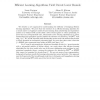Free Online Productivity Tools
i2Speak
i2Symbol
i2OCR
iTex2Img
iWeb2Print
iWeb2Shot
i2Type
iPdf2Split
iPdf2Merge
i2Bopomofo
i2Arabic
i2Style
i2Image
i2PDF
iLatex2Rtf
Sci2ools
120
click to vote
COLT
2006
Springer
2006
Springer
Efficient Learning Algorithms Yield Circuit Lower Bounds
We describe a new approach for understanding the difficulty of designing efficient learning algorithms. We prove that the existence of an efficient learning algorithm for a circuit class C in Angluin's model of exact learning from membership and equivalence queries or in Valiant's PAC model yields a lower bound against C. More specifically, we prove that any subexponential time, determinstic exact learning algorithm for C (from membership and equivalence queries) implies the existence of a function f in EXPNP such that f C. If C is PAC learnable with membership queries under the uniform distribution or Exact learnable in randomized polynomial time, we prove that there exists a function f BPEXP (the exponential time analog of BPP) such that f C. For C equal to polynomial-size, depth-two threshold circuits (i.e., neural networks with a polynomial number of hidden nodes), our result shows that efficient learning algorithms for this class would solve one of the most challengi...
COLT 2006 | Efficient Learning Algorithms | Equivalence Queries | Exact Learning | Machine Learning |
Related Content
| Added | 20 Aug 2010 |
| Updated | 20 Aug 2010 |
| Type | Conference |
| Year | 2006 |
| Where | COLT |
| Authors | Lance Fortnow, Adam R. Klivans |
Comments (0)

